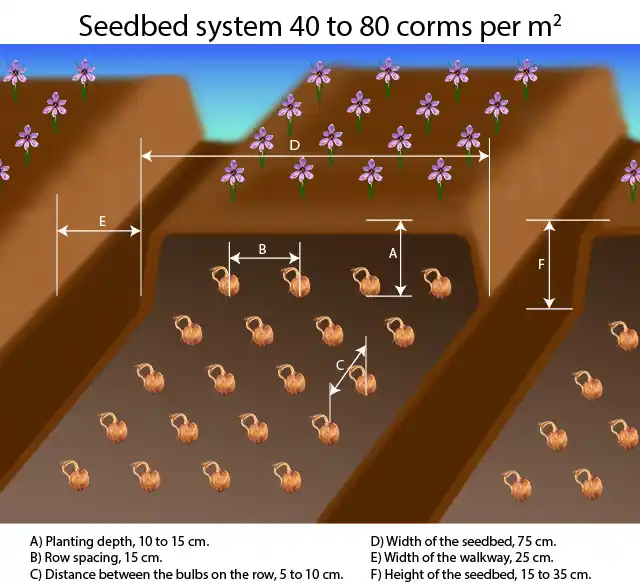The cultivation of saffron
Preparation
The soil selection
The Crocus sativus can be grown in many different soil types, provided it is well drained and not too wet. It is important to plant in "fresh" soil, preferably where flower bulb crops have never been grown before and certainly not from the same family as the crocus sativus, the Iridaceae. This is to prevent your bulbs from becoming ill due to residual germs, fungi, bacteria or nematodes.
To make a choice in which soil you will plant the bulbs, in addition to the moisture-retaining properties, you must also take into account the structure and workability of the soil. For example, on clay soil and soil with a lot of gravel and pebbles it will be much more difficult to get the bulbs properly in the ground than when you plant them in an easily workable sandy soil. The workability is also important if you want to dig up the bulbs from the ground after a few years to transplant them into fresh soil.
It is advisable to fertilize your land at least 10 weeks before planting with some old animal manure or good green compost. It is also important that you keep the land free of weeds as much as possible until the time of planting by mowing it regularly or working the soil shallowly with a garden cultivator or tiller from time to time. Just before planting, the soil can be plowed to make the soil loose and ready for planting.

The choice of which saffron bulbs to plant
We sell organically and conventionally grown Crocus sativus bulbs in various sizes.
The difference between organic and conventional bulbs is that organic bulbs are grown completely organically, without the use of chemical plant protection products and fertilizers. These bulbs are certified organic by Skal Biocontrol so that the harvested saffron can officially be called organic.
Conventional bulbs are grown in a sustainable manner, with minimal use of chemical crop protection and fertilizers.
The main difference between the different bulb sizes is that larger bulbs give better and more flowering in the first year of planting.
Bulbs of size 7/8 are the cheapest and will not or hardly flower in the first year of planting. Bulbs of this size are very suitable for setting up a multi-year crop in an economical way. Size 8/9 saffron bulbs have a bloom rate in the first year that is between 40 and 80 percent (40 to 80 flowers per 100 bulbs).
To ensure that you will have a reasonable saffron harvest in the first year, it is advisable to use Crocus sativus bulbs of size 9/10 or larger. Size 9/10 gives 1 to 2 flowers per bulb in the first year, bulbs of size 10/11 about 2 to 3 flowers per bulb and size 11/+, 3 or more flowers per bulb.
Under normal growing conditions, the flowering percentage of the bulbs will increase in subsequent years due to their multiplication and growth.
The plantation of the saffron bulbs
 The planting time of the Crocus sativus is between July and October.
The planting time of the Crocus sativus is between July and October.
Summer heat promotes flowering in the autumn, so if you live in an area with a temperate or cool summer, it is wise not to plant the bulbs until late August or early September. Until then, the bulbs can be stored in a dry and well-ventilated place, preferably at a temperature between 20 and 27 degrees Celsius.
If you want to plant the bulbs in an area with climatic conditions where summer temperatures regularly exceed 30 degrees Celsius, you can plant the bulbs in principle as early as the end of July. However, it is wiser to wait until mid-August because the bulbs are in their dormant phase and will not begin to germinate until the end of September.
The bulbs can be planted in different ways. The best way for you to plant the bulbs largely depends on the moisture permeability of your soil. If puddles remain on the land for a long time after a heavy rain shower, the moisture permeability is less good than if the puddles have already disappeared after an hour.
Saffron bulbs are almost always planted in rows on a planting bed, with a planting density of about 50 bulbs per square meter. To make a planting bed, a trench of about 15 centimeters deep is first dug along a line. The length of the trench depends on the number of bulbs and the size of the plot of land you want to plant. After the trench has been dug, you can place the bulbs in it in upright position, with their plumes pointing upwards, next to each other.
It is best to maintain a distance of 8 to 10 centimeters between the bulbs and about 15 centimeters between the rows.
When you have planted the first row, move the line 15 centimeters to the side and dig the next trench in the same manner as the first, covering the first trench with the soil that comes out of the second. After you have planted four rows like this, it is wise to keep a path of about 25 to 30 centimeters between the fourth and fifth rows so that you can walk between the planting beds, which makes activities such as weeding and of course harvesting the saffron easier. After every four rows you make such a path.
If you have a less permeable soil, it is best to dig the paths about 15 to 20 centimeters deep so that a "raised" planting bed is created where the paths serve to drain excess rainwater. With poorly draining soil, it is advisable to keep a path about 15 to 20 centimeters deep after every two rows.

The growth cycle of the Crocus sativus
- The bulb is in its dormant phase
- Sprout and root formation
- Flowering and leaf production
- Flowering and leaf development
- Further development of the leaves
- Growth of the leaves and production of new bulbs
- Further growth of the leaves and the new bulbs
- Reaching maximum leaf length and continued growth of the new bulbs
- Initiate leaf wilting and further growth of new bulbs
- The leaves are completely wilted. The new bulbs have reached their maximum growth and return to dormancy.
The care and maintenance of the saffron cultivation
Water
Because the Crocus sativus bulbs that you buy from us are dormant and this rest period lasts approximately from the end of June to the end of September, the bulbs do not need water in the summer.
As soon as the bulbs start to form roots and sprouts, you can start watering if no rain is forecast and the soil is dry. During the flowering period you could irrigate after harvesting the saffron if necessary.
In the spring, water is crucial for the Crocus sativus because then the new “daughter bulbs”, which have formed on top of the "mother bulb", must grow large enough to be able to form flowers in the fall.
During periods of drought from March to June, watering about 30 mm per week is highly recommended. It is best to give this amount in two times 15 mm of water, spread over two days.
Frost
 Despite the fact that the leaves of the Crocus sativus are green in winter, they can tolerate winter temperatures down to -15 degrees Celsius. However, it is wise to cover the crop with fleece or some straw if a period of frost with such low temperatures lasts for a long time or if there is a strong drying wind which can dry out the crop to such an extent that it dies.
Despite the fact that the leaves of the Crocus sativus are green in winter, they can tolerate winter temperatures down to -15 degrees Celsius. However, it is wise to cover the crop with fleece or some straw if a period of frost with such low temperatures lasts for a long time or if there is a strong drying wind which can dry out the crop to such an extent that it dies.
It is not a problem at all if the crop is covered with a layer of snow during a period of frost. Snow is the best covering material you can wish for during a severe winter, it ensures that the bulbs in the ground do not freeze and it keeps the leaves moist enough so that they do not suffer from the freezing cold.
Weeds
Make sure that your saffron plantation remains as free of weeds as possible throughout the year. Weeds can overgrow the crocus crop, causing the Crocus sativus bulbs to grow less than normal, which can result in less flowering.
When the Crocus sativus is above the ground with its green grassy leaves, it is best to remove the weeds by hand. It is especially necessary to ensure that the so-called root-propagated weeds do not get a chance to multiply in the planting bed. Root-propagated weeds are difficult to control because they have a hard-to-remove root system that continues to expand into the soil as the plant grows.
Common root-propagated weeds are for example: couch grass (Elymus repens), yellow fieldcress (Rorippa sylvestris) and ground elder (Aegopodium podagraria). In the summer period, when the bulbs are in 'rest' and have no leaves, you can keep the soil free of weeds by hoeing. Another technique that is also used is to burn off the weeds with a special gas burner.
Nutrition
If you feel that the crop needs some nutrition during growth, it is best to fertilize in early spring with, for example, some dried cow manure pellets or compound N-P-K fertilizer. Spread the fertilization over 2 or 3 smaller doses over a number of weeks, preferably when the weather is favorable for growth and before rainfall or sprinkling. The amount of fertilizer required strongly depends on the amount of absorbable nutrients in the soil. Keep in mind that if the soil temperature rises, more nutrients are released for the crop that are already present in the soil. Temperature influences the solubility reactions of various nutrients and releases a larger amount of nutrients into the soil at higher temperatures. It is therefore important not to fertilize too much, especially when the soil temperature is still quite low.
Damage caused by wildlife during the cultivation of saffron
During the cultivation of saffron, you may need to protect the bulbs and the crop against wild animals.
For animals such as roe deer and hares, the green leaves of the Crocus sativus are a very welcome treat, especially in the winter months. If these animals are near your plantation, they will graze the leaves to the bottom if given the chance. To prevent this, you could fence the plantation with fencing net.
Rodents such as voles and mice, on the other hand, love the bulbs that are underground. These animals are capable of causing a lot of damage to your plantation without you immediately realizing it. Once you notice plants turning brown and dying, it's usually too late and they've already eaten a large portion of your bulbs.
To prevent this, we give you below a number of measures that you can take that keep these animals at a reasonable distance, but certainly do not offer a 100% guarantee.
Shielding
 You can cover your saffron field with some fine-meshed chicken wire after planting so that harmful rodents don't get a chance to get into the soil to eat your bulbs. Even though the diameter of the mesh is often a bit larger than a mouse hole, the animals don't like it and will think twice before digging.
You can cover your saffron field with some fine-meshed chicken wire after planting so that harmful rodents don't get a chance to get into the soil to eat your bulbs. Even though the diameter of the mesh is often a bit larger than a mouse hole, the animals don't like it and will think twice before digging.
Stench
You could use the technique of companion planting by surrounding your saffron plantation with a "smelly" crop like garlic. Voles and mice dislike strong-smelling crops. An ornamental flower bulb crop such as Fritillaria Imperialis (Emperor's Crown) also has a repellent effect against these animals with its strong scent.
Vibrations
Mice and voles do not like vibrations in the ground and will leave if they detect them. You could create vibrations in the ground by placing thin metal pins in the ground spread over the field, over which you place PET bottles upside down or mount some kind of windmill. As soon as the wind blows, it will transfer vibrations to the ground and scare away the rodents.
Ultrasonic sound
Pest animals can also be chased away with ultrasonic sound. For example, there are devices available in the specialist trade that operate on electricity or batteries and produce sounds that are inaudible to humans, but audible to animals. The very high frequency and strong intensity ensure that rodents no longer feel comfortable and will leave.
Catch
Voles and mice can, of course, also be caught by using conventional or live mousetraps. In the specialist trade you can find a wide range of products to catch these rodents. We strongly advise against combating rodents with poison. The reason for this is that you often not only poison mice or rats, but also very useful predators such as falcons, buzzards and owls that catch and eat these rodents.
The grubbing and transplanting of saffron bulbs
In the commercial cultivation of saffron, the Crocus sativus bulbs are left in the ground for at least 5 consecutive years, after which they are dug up and transplanted into fresh soil. This is done because the flowering and thus the saffron yield decreases after a number of years. Because the bulbs multiply every year, at some point they don't have enough space in the ground to develop properly and grow large enough to flower. Normally, the saffron yield is at its peak in the third year after planting, after which it remains stable for a number of years and then declines.
Summer heat promotes flowering in the autumn and because the climate in the countries where commercial saffron cultivation is concentrated ensures that the bulbs receive sufficient heat in the soil during the summer period, the bulbs can remain in the soil for several years in a row.
In countries with a temperate or cool summer, it is strongly recommended not to leave the bulbs in the open ground for more than two years in a row. If you decide to take the bulbs out of the ground after some time to transplant them, it is best to do this as soon as the leaves are completely brown and withered in June. The bulbs are then in their resting (dormant) phase, which lasts about 3 months.
Once you have lifted the bulbs from the ground, they should be dried and cleaned, after which you can sort them in different sizes. Until planting, it is best to store the bulbs in a dry, sheltered and well-ventilated place. Store the bulbs at a temperature between 20 and 27 degrees Celsius to give the bulbs sufficient summer heat.
When transplanting, make sure you do not plant the bulbs back on the same land where saffron has already been grown. For some obscure and mysterious reason, Crocus sativus bulbs planted back on the same plot will develop poorly and suffer disease. The funny thing is that if you have planted the bulbs in fresh soil and leave them in the same soil for several years in a row, this will not be the case.

The saffron harvest
Between mid and late October, the largest Crocus sativus bulbs will begin to flower. Depending on the weather conditions, the period in which new flowers emerge from the ground lasts about three weeks.
The saffron harvest can begin during this period, with the entire flower usually picked when it has just opened. It is often said that the flowers are best picked early in the morning before the flowers open, but we think that is a bit nonsense. Besides the fact that it is difficult to pick unopened flowers properly and undamaged, the pistils in the flower will be slightly longer when the flower is open, so that they are easier to remove later.
The stripping of the saffron flowers
 After the opened flowers have been picked, they are often spread out on a table, after which the pistils can be manually removed from the flower. Each flower has three stigmas that are attached to each other with their white ends. Because the best saffron consists only of the red part of the pistils, also called the stigmas, it is best to throw away the part where the pistil changes from red to light yellow and white. In the end, you will only have the beautiful red parts that you then collect in a container or on a dish.
After the opened flowers have been picked, they are often spread out on a table, after which the pistils can be manually removed from the flower. Each flower has three stigmas that are attached to each other with their white ends. Because the best saffron consists only of the red part of the pistils, also called the stigmas, it is best to throw away the part where the pistil changes from red to light yellow and white. In the end, you will only have the beautiful red parts that you then collect in a container or on a dish.
The drying of the saffron pistils
 When enough stigmas have been collected, we can start drying. Make sure that the stigmas that are harvested are dried on the same day to avoid loss of quality. Saffron flowers that have not yet been stripped can be kept refrigerated for several days, although this is not preferred.
When enough stigmas have been collected, we can start drying. Make sure that the stigmas that are harvested are dried on the same day to avoid loss of quality. Saffron flowers that have not yet been stripped can be kept refrigerated for several days, although this is not preferred.
Drying saffron stigmas can be done in different ways.
The most traditional way is to roast the stigmas over hot coals or a wood fire. You can do this by spreading them out on a very fine mesh grid and roasting them over the heat source until the saffron threads are sufficiently dry.
Fortunately, nowadays there are more modern ways of drying herbs that are easier to control. For example, you can spread the fresh threads on an oven grid lined with baking paper and let them dry in the middle of a (convection) oven. At a temperature of about 50 to 60 degrees Celsius, drying takes between 15 and 30 minutes, depending on the type of oven and the amount you are drying at a time. The saffron is dry when it feels slightly crispy and no longer sticks together. The threads then have a vibrant dark red color with dark orange edged ends.
There are also special spice dryers on the market that are very suitable for drying saffron threads.
The conservation and storage of the saffron threads
After the saffron threads have dried, they should be packed airtight, for example in a glass jar or a tightly closed tin. Store the saffron in a cool, dry and dark place and it will be ready to use after about a month. Saffron can be kept for one and a half to two years without loss of quality.






















 BIO bulbs
BIO bulbs
 NON-BIO bulbs
NON-BIO bulbs
 Wholesale
Wholesale
 Miscellaneous flower bulbs
Miscellaneous flower bulbs
